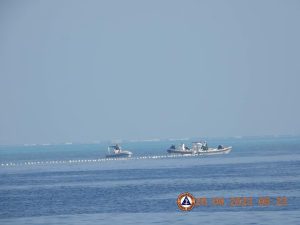The Philippines is set to toughen its stance in the South China Sea following a string of incidents involving Chinese coast guard vessels, a navy admiral said yesterday.
Vice Adm. Alberto Carlos, the chief of the Armed Forces of the Philippines (AFP)’s Western Command, or Wescom, told journalists that the Marcos administration was in the midst of forming “a national strategy” to defend its South China Sea, which would involve a “stronger assertion of rights in the sea.”
Carlos, whose Palawan-based command covers the Philippines’ possessions in the South China Sea, spoke just days after the Philippine Coast Guard (PCG) discovered a 300-meter submerged barrier that Chinese vessels allegedly installed at Scarborough Shoal. The PCG reported that the barrier had prevented Filipino fishermen from accessing the fish-rich central lagoon of the shoal.
While the shoal lies around 200 kilometers west of the Philippine island of Luzon, and well within Manila’s exclusive economic zone, it has been occupied by China since a stand-off between the two countries in 2012.
Arguing that it “posed a hazard to navigation, a clear violation of international law,” the PCG this week removed the rope and net barrier, following an order from President Ferdinand Marcos Jr.
Chinese Foreign Ministry spokesperson Wang Wenbin responded on Tuesday by describing the Philippine action as a “farce that entertains itself.”
“China firmly upholds the sovereignty and maritime rights of [Scarborough Shoal], and we advise the Philippines side not to provoke and cause trouble,” Wang told a regular press briefing in Beijing.
Carlos said yesterday that Filipino forces would dismantle any floating barrier that the China Coast Guard (CCG) installs in contested waters.
According to The Associated Press, he expressed concerns that the CCG might install a similar barrier at the entrance to Second Thomas Shoal, which is occupied by a small Philippine navy contingent that is stationed on the BRP Sierra Madre, a World War II-era warship that was grounded on the shoal in 1999 in order to reinforce the Philippine claim.
The shoal, known to the Philippines as Ayungin Shoal, has also experienced a number of recent incidents in which China Coast Guard vessels have attempted to prevent the AFP from resupplying the troops aboard the Sierra Madre – twice successfully.
“My concern is, if they also put a barrier in Ayungin … we also have to remove the barrier,” Carlos said. “Whatever they install, we will remove.”
He also said that the AFP would seek both to bolster the presence on Philippine-occupied features, and to establish “a stronger naval presence in our area.” The strategy would allow the military to “know what is happening in our area, precisely where they are, where are all the vessels of interest, the militia vessels, the Chinese Coast Guard,” he added.
The Philippine strategy makes sense, given that the persistent Chinese “gray zone” pressure is designed to probe for weak spots in the Philippine defenses and, through sheer attrition, to alter the balance of power at sea. In this context, showing that it is willing to push back forcefully – while documenting Chinese actions for the benefit of the press – is about the best strategy available to it.

































